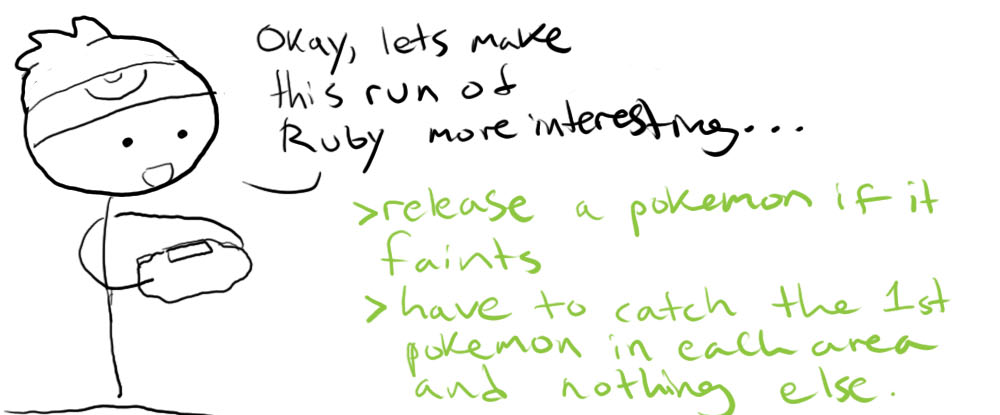I’m a huge fan of Pokémon. I remember as a kid spending countless hours playing and replaying Pokémon Silver on my Gameboy Colour. I loved capturing new Pokémon, leveling up my team, and battling my way to Red at the top of Mt. Silver. At the time, it was the perfect experience for me.
When I was in high school, Nintendo released a remake of Pokémon Silver on the DS called Pokémon Soul Silver. I remember at the time being so excited to play my favourite Pokémon game again. But when I sat down to play it, I honestly felt pretty disappointed. To be clear, I wasn’t disappointed because I thought the game was bad (to this day I still think Pokémon Soul Silver is one of the best Pokémon games ever made), but because I just didn’t feel the same magic I felt when I was a kid. I already knew the story, I already knew the Pokémon, and the whole experience just felt too predictable. I wanted a way to make it feel new and challenging again. That’s when I discovered the Nuzlocke Challenge.
If you’ve never heard of it before, the Nuzlocke Challenge is a self-imposed set of rules meant to increase the difficulty of Pokémon games. There are two core rules for the challenge:
The core rules of the Nuzlocke challenge (source).
Only the first Pokémon you encounter in an area can be captured. For example, if the first wild Pokémon you encounter on Route 1 is a Rattata, it’s the only Pokémon that you can catch on Route 1.
Any Pokémon that faints is considered dead and can no longer be used for the rest of the game. That Pokémon must either be released or permanently stored in the PC.
There are many variations and optional rules you can use to tailor your Nuzlocke Challenge, mostly to make it easier or harder. Some of these rules include:
You must give all your Pokémon nicknames to help form a stronger bond with your team. This rule is so common it is often lumped in as a core rule for the challenge.
Your Starter Pokémon is chosen at random, or your Starter Pokémon must be released as soon as you catch your first wild Pokémon.
You can ignore duplicates when encountering new Pokémon in an area. For example, if you already caught a Rattata on Route 1 and encounter another one on Route 2, you can ignore it and catch the next new Pokémon you encounter instead.
You cannot use Pokémon Centers, or you cannot use items for healing.
Allowing a “Mercy Rule” for second chances if a team member faints.
I had a blast playing through my Nuzlocke Challenge. My MVP was Milkshakes the Miltank that carried me all the way to the end. For me, the Nuzlocke challenge was the exact twist I needed to regain my love of Pokémon. It felt like I was transforming Pokémon into a Roguelike where I was forced to use Pokémon I would have normally ignored. I liked how high the stakes felt when a key member of my team got taken out, and how it forced me to adapt to the situation I was in. I completely recognize that this challenge isn’t for everyone, but if you think it sounds interesting, I suggest you give it a try.
Nuzlockes are far from the only self-imposed challenges players have come up with. From speed running to pacifist challenges, there are a lot of creative ways to change the stakes of our favourite games. Skip the Tutorial has a great series highlighting some of these unique twists. What I love about these challenges is that they allow players to gain agency over what they are playing and turn it into the experience that they want. But there’s a common thread I’ve noticed in all these self-imposed challenges: they all involve making the game harder.
That likely doesn’t seem like much of a revelation, does it? But I think what these challenges are trying to do is adjust the difficulty of games to better suit the player. It’s not necessarily about making the game more difficult, rather it’s about making it the right difficulty for that player. When I was playing through my Nuzlocke Challenge, it wasn’t just about making the game more difficult. It was about making it feel new again. It was about changing the Pokémon experience entirely. While there should certainly be self-imposed ways to make a game more difficult, maybe there should also be self-imposed ways of making a game easier as well.
It’s simple to change the rules of a tabletop game to adjust the difficulty. You could just decide that the players have more health, or draw extra cards, or gain extra resources. On the flip side, you could give yourself a handicap if you want to make it harder. It’s just as simple as changing a rule you don’t like. Because it’s up to the players to enforce the rules, they can selectively choose which rules to enforce to modify their experience (so long as all the players are on board with it).
It gets significantly trickier with video games. Because video games enforce their own rules, it can be difficult for players to change them (especially to make the game easier). Outside of adjusting the difficulty settings or using built-in assist modes, it might seem like there’s not much you can do. But there are a few options.
Mods are a perfect example of tinkering with the rules of a game to transform it into what you want. You can modify games to be easier, harder, or just wildly different from how it was created. While finding and using mods may not always be very user-friendly, they are a good option for customizing your experience to your needs.
Save-scumming is another contentious option if the game you’re playing features save files. If you’ve never heard the term before, save-scumming is when you reload an old save file so that you can change the choices or outcomes in your game. It’s often frowned upon as cheating, but maybe it shouldn’t be. While it does often go against the designer’s intentions, it might be valuable if you are seeking a very specific type of experience or narrative.
Ultimately, I think it’s important to realize every player is unique and is looking for different things in the games they are playing. Many players are going to be perfectly satisfied playing the game as intended. But sometimes, that just isn’t going to be the experience you want, and that’s okay. Whether to make it easier, harder, or just different, you should always have the power to adjust your games into the experiences that you want.


